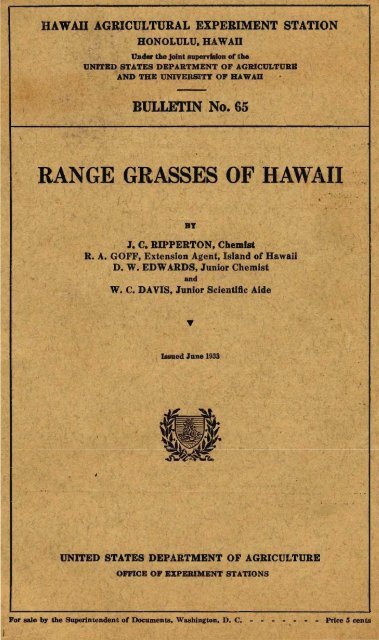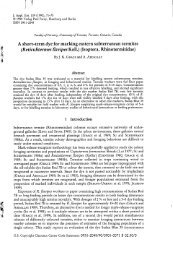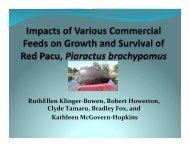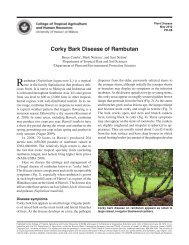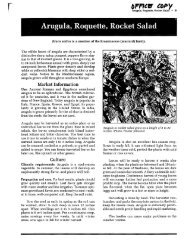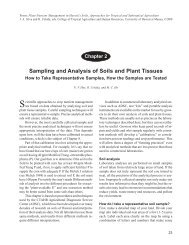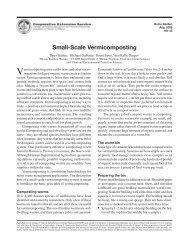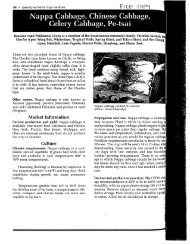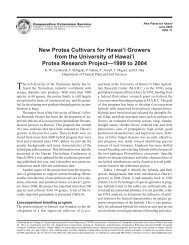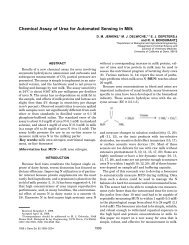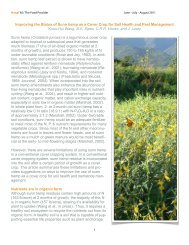RANGE GRASSES OF HAWAIl - ctahr - University of Hawaii
RANGE GRASSES OF HAWAIl - ctahr - University of Hawaii
RANGE GRASSES OF HAWAIl - ctahr - University of Hawaii
You also want an ePaper? Increase the reach of your titles
YUMPU automatically turns print PDFs into web optimized ePapers that Google loves.
4 BULLETIN 65, HAWAII EXPERIMENT STATION<br />
No.2. ANDROPOGON ANNULATUS<br />
Common name: Angleton grass<br />
Angleton grass grows in India, where it is regarded as one <strong>of</strong> the<br />
best wild grasses. It is especially well suited to areas <strong>of</strong> heavy rainfall,<br />
FIGURE 2.-Andropogon annulatu8<br />
is a perennial, and semierect, attaining a height <strong>of</strong> 5 feet or more under<br />
optimum conditions. The grass is said to be greatly relished by cattle,<br />
and is used both for pasturing and for hay. It has been grown experimentally<br />
at the station in Honolulu for a number <strong>of</strong> years, but has<br />
not been tried to any great extent on the open ranges. .
<strong>RANGE</strong> <strong>GRASSES</strong> <strong>OF</strong> HAWAII<br />
No.5. ANDROPOGON SERICEUS (1, p. 204)<br />
Common names: Australian bluegrass, Queensland bluegrass<br />
Australian bluegrass (6, p. 216) or Queensland bluegrass (1, p. 203)<br />
is.erect or semierect and usually not more than 2 feet tall. In <strong>Hawaii</strong><br />
it is regarded as a valuable grass for low, dry lands, particularly on<br />
FIGURE 5.-Andropogon 8ericetis<br />
Maui. The grass is palatable even when mature. It is hardy and<br />
will crowd out many <strong>of</strong> the undesirable grasses and weeds. Australian<br />
bluegrass thrives under such dry conditions as are suitable for cactus<br />
and will withstand a moderate amount <strong>of</strong> grazing. It should, however,<br />
be rested or reseeded at intervals. Under field conditions the<br />
segments <strong>of</strong> the head are held tightly together, giving to the whole<br />
the appearance <strong>of</strong> a solid head. When forced open the head is found<br />
to have three or more segments.<br />
7
8 BULJ.JETIN 65, HAWAII EXPERIMENT STATION<br />
No.6. ANTHOXANTHUM ODORATUM (6,p.168)<br />
Common name: Sweet vernal grass<br />
A native <strong>of</strong> Europe (6,p.167-169),sweet vernal grass is also found<br />
growing in the temperate regions <strong>of</strong> North America. It was collected<br />
on Molol{ai in 1912 and is now generally distributed over the several<br />
FIGURE 6.-Anthoxanthum odoratum<br />
<strong>Hawaii</strong>an islands. It is perennial, erect, and attains a height <strong>of</strong> 1 to 2<br />
feet. It thrives and seeds heavily in the higher elevations <strong>of</strong> Puu 00<br />
and Hllmuulu, <strong>Hawaii</strong>. The dried grass has a pronounced sweet smell,<br />
whence its name. Livestock will not eat this grass readily, and it<br />
may prove to be a pest in llplands where it seeds heavily.
10 BULLETIN 65, HAWAI:r- EXPERIMENT STATION<br />
No.8. AXONOPUS COMPRESSUS, PASPALUM COMPRESSUM (5, p. 224)<br />
Common name: Carpet grass<br />
Carpet grass is a native <strong>of</strong> tropical America. It is <strong>of</strong> .considerable<br />
importance to the, stock industry <strong>of</strong> the Gulf States (5, p. 224), and has<br />
a wide range <strong>of</strong> adaptability to soil and moisture conditions. In <strong>Hawaii</strong><br />
carpet grass makes its most important growth in pastures below<br />
2,000 feet. It is a perennial, attaining a height <strong>of</strong> 5 to 10 inches,<br />
spreads by runners,and, under grazing conditions, forms a dense sod.<br />
It is among the most persistent <strong>of</strong> all <strong>Hawaii</strong>an grasses, crowding out<br />
most weeds and other grasses, and withstanding heavy and continuous<br />
grazing. It is fairly well liked by livestock, being more palatable<br />
FIGURE 8.-Axonopus compressus<br />
than Hilo grass (Paspalum conjugatum) and rice grass (P. orbiculare,<br />
but less so than Australian water grass or Dallis grass (P. dilatatum).<br />
Carpet grass covers a large part <strong>of</strong> the pastures in the wet districts<br />
<strong>of</strong> Kauai, and will furnish fair pasturage, especially when sown with<br />
the sensitive plant. However, it is not liked by local ranchers because<br />
it crowds out other more nutritious grasses. It is being propagated<br />
on pahoehoe lands in the Puna district because it supersedes and<br />
smothers out the rice grass growing there. Carpet grass crowds out<br />
Hilo grass on the Parker ranch, but is not allowed to get into the paddocks<br />
where bromegrass, bur clover, and ryegrass are established.<br />
Carpet grass is encouraged in the Kona district where other grasses<br />
have not become established. Its dense, matted sod is said to aid<br />
materially in repressing the guava, an ever-encroaching pest on Kona<br />
pasture lands.
14 BULLETIN 65, HAWAII EXPERIMENT STATION<br />
No. 12. CHLORIS RADIATA (6,p.164)<br />
Ohloris radiata was originally described. from Jamaica (6, p. 163<br />
165). It is distributed throughout Central America at medium and<br />
FIGURE 12.-Chloris radiata·<br />
low altitudes. In <strong>Hawaii</strong> it was found growing as early as 1895.<br />
C. radiata grows along the roadsides and to a limited eX,tent in the<br />
pastures <strong>of</strong> Oahu. Together with C. injlata it is one <strong>of</strong> the chief pests<br />
in the alfalfa fields at Wailupe, Oahu. .It· is generally regarded as<br />
undesirable, although somewhat more palatable than C. injlata.
<strong>RANGE</strong> <strong>GRASSES</strong> <strong>OF</strong> HAWAII<br />
No. 13. CYNODON DACTYLON, CAPRIOLA DACTYLON .(6, p.16Z)<br />
Common names: Bermuda grass, manienie<br />
Bermuda grass is a native <strong>of</strong> the Mediterranean region (6, p. 161)<br />
and 'southern Asia, and is widely distributed over the warmer regions<br />
<strong>of</strong> both hemispheres, extending through the Tropics well up into<br />
the Temperate Zones. In <strong>Hawaii</strong> it was noted growing as early as<br />
1895. It is perennial, and under favorable conditions attains a height<br />
<strong>of</strong> 1 foot. Bermuda gr.ass spreads rapidly by means <strong>of</strong> runners<br />
ranging. from a few inches to several feet in length. While Bermuda<br />
grass will thrive'under moist conditions, it is valued in.<strong>Hawaii</strong> chiefly<br />
because <strong>of</strong> its ability t? grow under dry conditions where the better<br />
FIGURE 13.-Cllnodon dactlllon<br />
grasses fail. It does not thrive in combination. with other grasses,<br />
but grows I well with various clovers, such as yellow sweetclover<br />
(Melilotu.s ojficinalis), bur clover (Medicago denticulata), Japan clover<br />
(Lespedeza striata), and blackmedick (M. lupu-lina). Bermuda grass<br />
forms the foundation <strong>of</strong> most <strong>of</strong> the pastures <strong>of</strong> Molokai, Maui,<br />
Oahu, and <strong>Hawaii</strong>, from sea level to altitudes <strong>of</strong> more than 4,000 feet,<br />
except in the wetter regions where it is displaced by Hilo grass and<br />
by carpet grass. Bermuda grass is relished by cattle when it is not<br />
too old, and is <strong>of</strong> fair value for fattening. Ranchmen state that<br />
pigeon peas will thrive in a locality in which Bermuda grass makes<br />
good growth. .<br />
A giant variety <strong>of</strong> Oynodon dactylon has been tried at the station<br />
in Honolulu for several years and seems to have considerable merit.<br />
It spreads rapidly, produces an abundance <strong>of</strong> feed, and appears to<br />
·be as palatable as the common variety.<br />
16
20 BULLETIN 65, HAWAII EXPERIMENT STATION<br />
No. lB. ELEUSINE INDICA (6, p.160)<br />
Common names: Crowfoot, goose grass or yard grass<br />
Eleusine ind1:ca was originally described from India (6, p. 161), and<br />
is common to the Tropics. It was fir"t collected on Oahu in 1902.<br />
FIGURE 18.-Eleusine indica<br />
USllally annual, but sometimes perennial, ,vith semierect or spreading<br />
stems, yard grass is, <strong>of</strong>ten classed as a weed. Locally, however, it is<br />
,regarded as a good maintenance gra,ss and is readily eaten by cattle<br />
and by horses ,vhen the more succulent grasses are not available.
22, BULLETIN 65, HAWAII EXPERIMENT STATION<br />
No. 20. FESTUCA ELATIOR (14, pl. 81) .<br />
Q)mmon names: Meadow fescue, tall fescue<br />
Meadow fescue is found- growing throughout England and continental<br />
Europe. An erect perennial, 2 to 4 feet tall, it spreadd rapidly<br />
b.y means <strong>of</strong> creeping stems. It is said to be valuable for hay and for<br />
FIGURE 20.-Festuca elatior<br />
pasturage, and is. adapted to both dry and wet clinlates. In Europe<br />
it is grown in combination with ryegrass, orchard grass, timothy, and<br />
with red, white, and alsil{e clovers. The grazing qualities are said to<br />
be good. Meadow fescue did well in .the grass garden at Waimea,<br />
<strong>Hawaii</strong>, and seems to be worthy <strong>of</strong> further trial.<br />
,"
26 BULLETIN 65, HAWAII EXPERIMENT STATION<br />
, No. 24. LOLIUMMULTIFLORUM (6, p.l3S)<br />
Common name: Italian ryegrass<br />
Italian ryegrass was originally- described fr<strong>of</strong>fi,Europe (6, p'. 141),<br />
being a natlve <strong>of</strong> Italy. It was recorded in Ha,vaii in 1903. It is one<br />
<strong>of</strong> the oldest <strong>of</strong> the cultivated grasses and together with perennial<br />
(English) ryegrass (Lolium :perenne) occupies an important place in<br />
European agricultllre. In Ha"vaii the grass is considered va.Iuable on<br />
FIGURE 24.-Lolium muUijloTum<br />
the Parker and the Shipman ranches in both wet and dry districts at<br />
the higher elevations. It is an erect, short-lived perennial, 2 to 3 feet<br />
tall.. It is usually grO"TJl in combination ",ith other grasses and with<br />
clovers. It reseeds well and if allowed to rest occasionally will grow<br />
permanently on the upper areas. It is very palatable, and is neariy as<br />
valuable as bromegrass, although not so widespread. Italian ryegrass<br />
can be aistinguished from English ryegrass by its awns. The two species<br />
are <strong>of</strong> practically equal vaJue. A species known as darnel (L.<br />
tem1tlentum) has also been reported as growing in <strong>Hawaii</strong>. It is poisonous<br />
and is regarded as a pest. .
34 BULLETIN 65, HAWAII EXPERIMENT STATION<br />
No. 32. PASPALUM FIMBRIATUM (6,p.174j<br />
Common name: Panama paspalum<br />
. Panama paspalum is found growing in Panama, the West Indies,<br />
and in the northern. part <strong>of</strong> ·South:America. It is at home in open;<br />
waste ground, mostly in moist places. It is an annual, semierect,<br />
and 1 to 3 feet tall. In <strong>Hawaii</strong> it grows along the roadsides in numerous<br />
places on Oahu. Little is known regarding its forage value.
<strong>RANGE</strong> <strong>GRASSES</strong> <strong>OF</strong> HAWAII 35<br />
No. 33. PASPALUM NOTATUM<br />
Common name: Bahia grass<br />
.Bahia gr(tss is a native <strong>of</strong> South America and the territory northward<br />
to Mexico. It also grows. in the West Indies. It is a perennial,<br />
stools rapidly, and attains a height <strong>of</strong> 1 to 2 feet. It is very hardy,<br />
FIGURE 33.-Paspalum notatum<br />
being drought resistant and likewise thriving under moist conditions.<br />
It persists at elevations ranging a8 high as 6,500 feet in Mexico. In<br />
Australia it withstands heavy and continuous grazing after it becomes<br />
established. It has been tried experirrlent'ally at Waimea, Ha\\raii,<br />
where the elevation is 2,600 feet. It grew. vigorously' and spread<br />
with great rapidity. Little i8 known about its palatability, but its<br />
vigor and rapidity <strong>of</strong> growth seem to deserve further trial.
38 BULLETIN 65, HAWAII EXPERIMENT STATION<br />
No. 36. PENNISETUM CLANDESTINUM<br />
C-ommon name: Kikuyu<br />
Kikuyu grass has ,been tested extensively in Australia,. particularly<br />
in New South Wales, and also in South Africa and east Africa (1, p.<br />
95). It was introduced into <strong>Hawaii</strong> from California in 1924. It is a<br />
perennial with vigorous surface and underground runners. It·sometimes<br />
grows 3 feet high on rich soil with ample moisture, but usually<br />
is 12 inches high or less. It seldom seed's in <strong>Hawaii</strong> and is propagated<br />
entirely from cuttings. It forms a sod not easily trampled out, and<br />
FIGURE 36.-Pennisetum clandestinum<br />
withstands grazing. Kikuyu grass spreads very rapidly and holds its<br />
own against practically all other grasses. In South' Africa it is said"<br />
to grow satisfactorily with white clover. Opinions <strong>of</strong> its palatability<br />
differ, some ranchmen stating that cattle eat it readily, others believing<br />
that stock must acquire a liking for it.<br />
In <strong>Hawaii</strong>, the grass is being planted from sea level to 6,000 feet in<br />
elevation. It is thriving at the latter altitude, and is said not to be<br />
affected by the light frosts there. It is too early to predict the future<br />
<strong>of</strong> kikuyu grass in <strong>Hawaii</strong>, but unless it shows some undesirable feature<br />
it will be planted widely to supplant some less desirable kinds.<br />
In Australia it is being substituted for Dallis grass (Paspalum dilatatum)<br />
because it grows more rapidly.
<strong>RANGE</strong> <strong>GRASSES</strong> <strong>OF</strong> .HAW·AII, 41<br />
No. 39. PHALARIS TUBEROSA, P. BU,LBOSA (1, p. 241)<br />
Phalaris tuberosa, a native <strong>of</strong> the Mediterranean regions <strong>of</strong> Europe<br />
(1, p. 239), is an erect perennial, and spreads rapidly by stooling. In<br />
other countries it is said to resist drought and frost remarkably well.<br />
In <strong>Hawaii</strong> it is an excellent grass for high, cold, wet districts, and withstands<br />
heavy grazing, particularly if lightly stocked during the first<br />
year. The grass recovers quickly after it has been grazed and produces<br />
a large amount <strong>of</strong> feed. It is said to form a good mixture with<br />
"\\Thite clover, and is regarded as exceptionally palatable, the equal or<br />
superior <strong>of</strong> ryegrass, cocJ:tsfoot, and Dallis grass. Phalaris tuberosa is<br />
recommended for trial in <strong>Hawaii</strong> at elevations above 2,500 feet.<br />
P. stenoptera, a form <strong>of</strong> P. tuberosa, with a.' less well-developed bulbous<br />
base, and sometimes with short rhizomes, is commonly called<br />
Perllvian winter grass or Harding grass. It has been tried locally, and<br />
is to be recommended for trial.
<strong>RANGE</strong> <strong>GRASSES</strong> <strong>OF</strong> HAWAII<br />
No.41. RHAPmS ACICULATA, CHRYSOPOGON ACICULATUS, ANDROPOGON ACICULATUS<br />
(6, p. 218)<br />
Common name: Pilipiliula<br />
Pilipiliula grass was originally. described from the East Indies (6,<br />
p. 219-221). In <strong>Hawaii</strong> it occupies a considerable area on the several<br />
FIGURE 41.-Rhaphis aciculata<br />
islands. It is a perennial, 4 to 12 inches tall, and spreads by means <strong>of</strong><br />
creeping stems that root at the joints. It is said to be able to crowd<br />
out Bermuda grass, but in turn can be displaced by carpet'grass.<br />
Cattle eat pilipiliula grass sparingly, and nearly all ranchmen regard<br />
it as undesirable.<br />
•<br />
43
44 BULLETIN '65, HAWAII EXPERIMENT STATION<br />
No. 42. SACCIOLEPIS CONTRACTA (6,p'.'198)<br />
Common nam.e: Glenwood grass<br />
Glenwood grass" originally described from the East Indies (6, p.<br />
199), grows in 'abundanee in the Glenwood district, <strong>Hawaii</strong>, and is<br />
FIGURE 42.-Sacciolepis contracta<br />
found on all the other islands. It is an annual., erect from a spreading<br />
base, and 1 to 2 feet tall. It seeds pr<strong>of</strong>usely, spreads rapidly, and is<br />
very persistent. On the poor, soggy soils <strong>of</strong> the Glenwood district it<br />
crowds out Hilo grass a,nd sedges. Cattle relish Glenwood grass and<br />
fatten on it. Its excellent qualities are not generally appreciated.<br />
•
<strong>RANGE</strong> <strong>GRASSES</strong> <strong>OF</strong> HAWAII<br />
No. 43. SETARIA LUTESCENS, SETARIA GLAlJCA, CHAETOCHLOA LUTESCENS (6,p.210)<br />
Common name: Yellow foxtail<br />
Setaria lutescens was originally, described from Europe (6, p. 207).<br />
The seed is said to have b'een brought into <strong>Hawaii</strong> in hay from Cali-<br />
FIGURE 43.-Setaria lutescens<br />
fornia. It is an annual, semierect, and usually not over 2 feet tall.<br />
It is regarded as one <strong>of</strong> the most undesirable <strong>of</strong> <strong>Hawaii</strong>an grasses.<br />
Cattle do not relish it and the hairy heads are said to give them throat<br />
trouble. It forces out most <strong>of</strong> the other grasses and grows as almost a<br />
solid stand in certain areas on Kauai.<br />
45
46 BULLETIN 65, HAWAII EXPERIMENT STA'TION<br />
No.4·i. SETARIA VERTICILLATA, CHAETOCHLOA VERTICILLATA (6,p. 204)<br />
Common name: Bristly foxtail<br />
Bristly foxtail was originally described from the Old World (4, p.<br />
178-180). It is an annual, erect or semierect, and attains a height <strong>of</strong> ]<br />
FIGURE 44.-Setaria verticillata<br />
to; 3 feet. It seeds pr<strong>of</strong>usely and is seasonal in growth, springing up<br />
after a heavy rain. Unlike yellow foxtail, bristly foxtail is regarded as<br />
a good feed, both for pasture and as a soilage crop. It is considered<br />
equal or superior to Para grass for milk production.
<strong>RANGE</strong> <strong>GRASSES</strong> <strong>OF</strong> HAWAII<br />
No. 45. SORGHUM VULGARE SUDANENSE, HOLCUS SORGHUM SUDANENSl8.<br />
ANDROPOGON SORGHUM SUDANENSIS (lO,p.37)<br />
('<br />
Common name: Sudan grass<br />
Sudan grass (10, p. 36) is cultivated in the warmer regions <strong>of</strong> both<br />
hemispheres. It is annual or perennial and 3 to 7 feet tall. Although<br />
making its best growth at lower levels it will grow at relatively high<br />
altitudes. It is as drought resistant as the best ,Tarieties <strong>of</strong> sorghums.<br />
In regions <strong>of</strong> low rainfall and high temperature its carrying capacity<br />
FIGURE 45.-Sorghum vulgare sudanense<br />
du;ring the summer is said to exceed that <strong>of</strong> any other grass or legume.<br />
It is also well adapted to irrigated regions. It is valuable as cut feed<br />
and also as pasturage if rested at intervals. The grass recovers<br />
rapidly after having been cut and produces heavily throughout the<br />
year. Sudan grass resembles Johnson grass (Sorghum halepense) in<br />
appearance, but has broader and more numerous leaves and no llnderground<br />
stems. So far as is known, Johnson grass is not used in <strong>Hawaii</strong><br />
either for pasture or for cut feed, but grows along the roadsides in many<br />
places. Although about equal in value to Sudan grass, Johnson grass<br />
is not recommended because <strong>of</strong> its underground stems, which make its<br />
eradication from cultivated fields difficult.<br />
47
<strong>RANGE</strong> -<strong>GRASSES</strong> <strong>OF</strong> HAWAII<br />
No. 49. TRICHOLAENA ROSEA: (6, p. 206)<br />
Common names: Natal grass, Natal redtop<br />
Natal grass, a native <strong>of</strong> Africa (6, p. 204-, 205), was reported in<br />
<strong>Hawaii</strong> as early as 1894, and is 'how scattered over all the islands. It<br />
is an erect perenIlial attaining a height <strong>of</strong> 3 feet or more, and spreads<br />
FIGURE 49.-Tricholaena rosea<br />
by means <strong>of</strong> underground stems and by seeds. In <strong>Hawaii</strong> it is valuable<br />
for the dry lands. It will lil(ewise grow on stony land in dry<br />
places where few other grasses survive. Natal grass withstands pasturing<br />
if it is allowed to rest and reseed itself at intervals. It is said<br />
to recover quickly after drought. The grass is tender and palatable<br />
when young but wiry and tough when old. Because <strong>of</strong> its abundant<br />
seeding it is regarded as a pest on sugar plantations. It can be propagated<br />
easily by scattering the dried mature grass containing the seed.<br />
51
52 BULLETIN 65, HAWAII EXPERIMENT STATION<br />
COMPOSITION<br />
Results <strong>of</strong> recent investigations have shown that analysis <strong>of</strong> a grass<br />
is <strong>of</strong> little value unless attention is, paid to the stage <strong>of</strong> maturity at<br />
which It is cut and to climatic conditions prevailing during its growth.<br />
Grass progresses from a succulent stage consisting entirely <strong>of</strong> leaves<br />
and sheaths, to a mature stage in which stems predominate and bear<br />
partly dried leaves or none at all. During this period the plant<br />
changes from an easily digested, concentr'ate feed <strong>of</strong> high protein<br />
content, to one high in fiber and low in protein and in digestibility.<br />
Table 1, compiled from data collected by the Waite Institllte (3, p. 23),<br />
illustrates the effect <strong>of</strong> the maturity <strong>of</strong> a plant on its protein and fiber<br />
content.<br />
T ABLE I.-Percentages <strong>of</strong> protein and crude fiber in dry weight <strong>of</strong> grass, as affected<br />
by cutting the grass 1 at different intervals<br />
Interval<br />
Crude I Interval<br />
Plat No. between Protein<br />
Crude<br />
fiber<br />
Plat No. between Protein<br />
.cuttings cuttings<br />
fiber<br />
Weeks Per cent Per cent Weeks Per cent Per cent<br />
1______ ..:..: __ ,_________ 2 14.56 18.84<br />
4___________________<br />
10 8.56 25,18<br />
2_______ ,____________ 4 14.00 23.43<br />
5___________________ (2) 5.00 29.93<br />
3___________________ 7 10.56 25.33<br />
1 Tbeherbage-a mixture <strong>of</strong> perennial and annual grasses, legumes, and miscellaneous species-was cut<br />
from adjoining plats.<br />
2 Plants were mature. End <strong>of</strong> the growinF; season.<br />
Table 2 gives information about each grass analyzed, where it was<br />
grown, and the stage <strong>of</strong> maturity at which it was cut. In most<br />
instances analyses were made <strong>of</strong> mature grasses only, all the leaves<br />
being green and the seed in the dough stage, approximating the condition<br />
in a rested paddock at the time when the cattle are turned in.<br />
f


